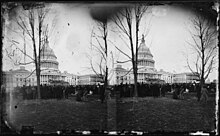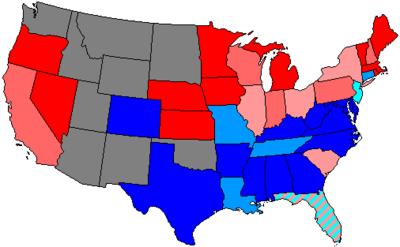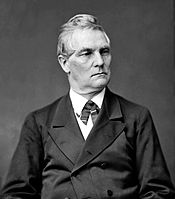45th United States Congress
| 45th United States Congress | |
|---|---|
44th ← → 46th | |
 United States Capitol (1877) | |
March 4, 1877 – March 4, 1879 | |
| Members | 76 senators 293 representatives 8 non-voting delegates |
| Senate majority | Republican |
| Senate President | William A. Wheeler (R) |
| House majority | Democratic |
| House Speaker | Samuel J. Randall (D) |
| Sessions | |
| Special[a]: March 5, 1877 – March 17, 1877 1st: October 15, 1877 – December 3, 1877 2nd: December 3, 1877 – June 20, 1878 3rd: December 2, 1878 – March 3, 1879 | |
The 45th United States Congress was a meeting of the legislative branch of the United States federal government, consisting of the United States Senate and the United States House of Representatives. It met in Washington, D.C. from March 4, 1877, to March 4, 1879, during the first two years of Rutherford Hayes's presidency. The apportionment of seats in the House of Representatives was based on the 1870 United States census. The Senate had a Republican majority, and the House had a Democratic majority.
The 45th Congress remained politically divided between a Democratic House and Republican Senate.[1] President Hayes vetoed an Army appropriations bill from the House which would have ended Reconstruction and prohibited the use of federal troops to protect polling stations in the former Confederacy.[1] Striking back, Congress overrode another of Hayes’s vetoes and enacted the Bland-Allison Act that required the purchase and coining of silver.[1] Congress also approved a generous increase in pension eligibility for Northern Civil War veterans.[1]
Major events
[edit]
| House seats by party holding plurality in state | |
|---|---|
80+% Democratic | 80+% Republican |
60+ to 80% Democratic | 60+ to 80% Republican |
Up to 60% Democratic | Up to 60% Republican |
- March 4, 1877: Rutherford B. Hayes became President of the United States
Major legislation
[edit]- February 28, 1878: Bland–Allison Act (Coinage Act (Silver Dollar)), Sess. 2, ch. 20, 20 Stat. 25
- April 29, 1878: National Quarantine Act of 1878, Sess. 2, ch. 66, 20 Stat. 37
- June 3, 1878: Timber and Stone Act, Sess. 2, ch. 151, 20 Stat. 89
- June 18, 1878: Posse Comitatus Act, Sess. 2, ch. 263, §15, 20 Stat. 152
Party summary
[edit]The count below identifies party affiliations at the beginning of the first session of this Congress, and includes members from vacancies and newly admitted states, when they were first seated. Changes resulting from subsequent replacements are shown below in the "Changes in membership" section.
During this Congress, two Senate seats and one House seat were added for the new state, Colorado.
Senate
[edit]| Party (shading shows control) |
Total | Vacant | ||||
|---|---|---|---|---|---|---|
| Anti- Monopoly (AM) |
Democratic (D) | Republican (R) | Independent (I) |
|||
| End of previous congress | 1 | 30 | 45 | 0 | 76 | 0 |
| Begin | 1 | 35 | 39 | 1 | 76 | 0 |
| End | 36 | 38 | ||||
| Final voting share | 1.3% | 47.4% | 50.0% | 1.3% | ||
| Beginning of next congress | 1 | 42 | 32 | 1 | 76 | 0 |
House of Representatives
[edit]| Party (shading shows control) |
Total | Vacant | ||||||
|---|---|---|---|---|---|---|---|---|
| Democratic (D) |
Independent Democratic (ID) | Independent | Independent Republican | Republican (R) | Greenback |
|||
| End of previous congress | 183 | 1 | 3 | 4 | 100 | 0 | 291 | 1 |
| Begin | 149 | 2 | 0 | 0 | 141 | 0 | 292 | 1 |
| End | 153 | 136 | 291 | 2 | ||||
| Final voting share | 52.6% | 0.7% | 0.0% | 0.0% | 46.7% | 0.0% | ||
| Non-voting members | 3 | 0 | 0 | 0 | 5 | 0 | 8 | 0 |
| Beginning of next congress | 145 | 4 | 1 | 0 | 131 | 11 | 292 | 1 |
Leadership
[edit]
William A. Wheeler
Senate
[edit]- President: William A. Wheeler (R)
- President pro tempore: Thomas W. Ferry (R)
- Republican Conference Chairman: Henry B. Anthony
- Democratic Caucus Chairman: William A. Wallace
House of Representatives
[edit]- Speaker: Samuel J. Randall (D)
- Democratic Caucus Chairman: Hiester Clymer
- Republican Conference Chairman: Eugene Hale
- Democratic Campaign Committee Chairman: Joseph Clay Stiles Blackburn
Members
[edit]This list is arranged by chamber, then by state. Senators are listed in order of seniority, and representatives are listed by district.
Senate
[edit]Senators were elected by the state legislatures every two years, with one-third beginning new six-year terms with each Congress. Preceding the names in the list below are Senate class numbers, which indicate the cycle of their election. In this Congress, Class 1 meant their term began in the last Congress, requiring reelection in 1880; Class 2 meant their term began in this Congress, requiring reelection in 1882; and Class 3 meant their term ended in this Congress, requiring reelection in 1878.
House of Representatives
[edit]The names of members of the House of Representatives are preceded by their district numbers.
Changes in membership
[edit]The count below reflects changes from the beginning of the first session of this Congress.
Senate
[edit]- Replacements: 5
- Democratic: 1 seat net gain
- Republican: 1 seat net loss
- Deaths: 2
- Resignations: 3
- Interim appointments: 1
- Contested elections: 0
- Total seats with changes: 5
| State (class) |
Vacated by | Reason for change | Successor | Date of successor's formal installation[b] |
|---|---|---|---|---|
| Ohio (3) | John Sherman (R) | Resigned March 8, 1877 to become U.S. Secretary of the Treasury. Successor elected March 21, 1877. |
Stanley Matthews (R) | March 21, 1877 |
| Pennsylvania (3) | Simon Cameron (R) | Resigned March 12, 1877. Successor elected March 20, 1877. |
J. Donald Cameron (R) | March 20, 1877 |
| Missouri (3) | Lewis V. Bogy (D) | Died September 20, 1877. Successor was appointed September 29, 1877, to continue the term. |
David H. Armstrong (D) | September 29, 1877 |
| Indiana (3) | Oliver P. Morton (R) | Died November 1, 1877. Successor elected January 31, 1879. |
Daniel W. Voorhees (D) | November 6, 1877 |
| Missouri (3) | David H. Armstrong (D) | Interim appointee retired. Successor elected January 26, 1879. |
James Shields (D) | January 27, 1879 |
| Michigan (1) | Isaac P. Christiancy (R) | Resigned February 10, 1879 due to ill health. Successor elected February 22, 1879. |
Zachariah Chandler (R) | February 22, 1879 |
House of Representatives
[edit]- Replacements: 10
- Democratic: 5 seat net gain
- Republican: 5 seat net loss
- Deaths: 7
- Resignations: 1
- Contested election: 5
- Total seats with changes: 13
| District | Vacated by | Reason for change | Successor | Date of successor's formal installation[b] |
|---|---|---|---|---|
| Georgia 9th | Vacant | Rep. Benjamin Harvey Hill resigned in previous congress | Hiram P. Bell (D) | March 13, 1877 |
| Colorado At-large | James B. Belford (R) | Lost contested election December 13, 1877 | Thomas M. Patterson (D) | December 13, 1877 |
| California 4th | Romualdo Pacheco (R) | Lost contested election February 7, 1878 | Peter D. Wigginton (D) | February 7, 1878 |
| Louisiana 3rd | Chester B. Darrall (R) | Lost contested election February 20, 1878 | Joseph H. Acklen (D) | February 20, 1878 |
| Louisiana 5th | John E. Leonard (R) | Died March 15, 1878 | J. Smith Young (D) | November 5, 1878 |
| Massachusetts 3rd | Walbridge A. Field (R) | Lost contested election March 28, 1878 | Benjamin Dean (D) | March 28, 1878 |
| New York 16th | Terence J. Quinn (D) | Died June 18, 1878 | John M. Bailey (R) | November 5, 1878 |
| Nebraska At-large | Frank Welch (R) | Died September 4, 1878 | Thomas J. Majors (R) | November 5, 1878 |
| Michigan 1st | Alpheus S. Williams (D) | Died December 21, 1878 | Vacant | Not filled this term |
| Virginia 1st | Beverly B. Douglas (D) | Died December 22, 1878 | Richard L. T. Beale (D) | January 23, 1879 |
| Georgia 1st | Julian Hartridge (D) | Died January 8, 1879 | William B. Fleming (D) | February 10, 1879 |
| Texas 6th | Gustav Schleicher (D) | Died January 10, 1879 | Vacant | Not filled this term |
| Florida 2nd | Horatio Bisbee Jr. (R) | Lost contested election February 20, 1879 | Jesse J. Finley (D) | February 20, 1879 |
Committees
[edit]Lists of committees and their party leaders for members of the House and Senate committees can be found through the Official Congressional Directory at the bottom of this article. The directory after the pages of terms of service lists committees of the Senate, House (Standing with Subcommittees, Select and Special) and Joint and, after that, House/Senate committee assignments. On the committees section of the House and Senate in the Official Congressional Directory, the committee's members on the first row on the left side shows the chairman of the committee and on the right side shows the ranking member of the committee.
Senate
[edit]- Agriculture (Chairman: Algernon S. Paddock; Ranking Member: Henry G. Davis)
- Appropriations (Chairman: William Windom; Ranking Member: Henry G. Davis)
- Audit and Control the Contingent Expenses of the Senate (Chairman: John P. Jones; Ranking Member: George R. Dennis)
- Civil Service and Retrenchment (Chairman: Henry M. Teller; Ranking Member: Thomas C. McCreery)
- Claims (Chairman: Samuel J. R. McMillan; Ranking Member: Francis M. Cockrell)
- Commerce (Chairman: Roscoe Conkling; Ranking Member: John B. Gordon)
- Distributing Public Revenue Among the States (Select)
- District of Columbia (Chairman: Stephen W. Dorsey; Ranking Member: Augustus S. Merrimon)
- Education and Labor (Chairman: Ambrose E. Burnside; Ranking Member: John B. Gordon)
- Elections of 1878 (Select)
- Engrossed Bills (Chairman: Thomas F. Bayard; Ranking Member: Henry B. Anthony)
- Epidemic Diseases (Select)
- Examine the Several Branches in the Civil Service (Select) (Chairman: Jerome B. Chaffee; Ranking Member: Augustus S. Merrimon)
- Finance (Chairman: Justin S. Morrill; Ranking Member: Thomas F. Bayard)
- Foreign Relations (Chairman: Hannibal Hamlin; Ranking Member: Thomas C. McCreery)
- Hot Springs (Arkansas) Commission (Special)
- Indian Affairs (Chairman: William B. Allison; Ranking Member: Thomas C. McCreery)
- Judiciary (Chairman: George F. Edmunds; Ranking Member: David Davis)
- Late Presidential Election Louisiana
- Manufactures (Chairman: Edward H. Rollins; Ranking Member: John W. Johnston)
- Mexican Relations (Select)
- Military Affairs (Chairman: George E. Spencer; Ranking Member: Theodore F. Randolph)
- Mines and Mining (Chairman: William Sharon; Ranking Member: Frank Hereford)
- Mississippi River Levee System (Select) (Chairman: Blanche Bruce; Ranking Member: Francis M. Cockrell)
- Naval Affairs (Chairman: Aaron A. Sargent; Ranking Member: William P. Whyte)
- Ordnance and War Ships (Select)
- Patents (Chairman: Newton Booth; Ranking Member: Francis Kernan)
- Pensions (Chairman: John J. Ingalls; Ranking Member: Robert E. Withers)
- Post Office and Post Roads (Chairman: Thomas W. Ferry; Ranking Member: Ambrose E. Burnside)
- Private Land Claims (Chairman: Allen G. Thurman; Ranking Member: Isaac P. Christiancy)
- Privileges and Elections (Chairman: Bainbridge Wadleigh; Ranking Member: John J. Ingalls)
- Public Lands (Chairman: Richard J. Oglesby; Ranking Member: Joseph E. McDonald)
- Railroads (Chairman: John H. Mitchell; Ranking Member: Stanley Matthews)
- Revision of the Laws (Chairman: Isaac P. Christiancy; Ranking Member: William A. Wallace)
- Revolutionary Claims (Chairman: John W. Johnston; Ranking Member: Henry L. Dawes)
- Rules (Chairman: James G. Blaine; Ranking Member: Augustus S. Merrimon)
- Tariff Regulation (Select)
- Tenth Census (Select) (Chairman: Justin S. Morrill; Ranking Member: N/A)
- Territories (Chairman: John J. Patterson; Ranking Member: Augustus H. Garland)
- Transportation Routes to the Seaboard (Select) (Chairman: Angus Cameron; Ranking Member: N/A)
- Treasury Department Account Discrepancies (Select) (Chairman: Henry G. Davis; Ranking Member: John J. Ingalls)
- Whole
House of Representatives
[edit]- Accounts (Chairman: Charles B. Roberts; Ranking Member: Henry W. Blair)
- Agriculture (Chairman: Augustus W. Cutler; Ranking Member: Walter L. Steele)
- Appropriations (Chairman: John DeWitt Clinton Atkins; Ranking Member: Eugene Hale)
- Banking and Currency (Chairman: Aylett H. Buckner; Ranking Member: Elizur K. Hart)
- Claims (Chairman: John M. Bright; Ranking Member: Daniel N. Lockwood)
- Coinage, Weights and Measures (Chairman: Alexander H. Stephens; Ranking Member: John B. Clarke)
- Commerce (Chairman: John H. Reagan; Ranking Member: John E. Kenna)
- District of Columbia (Chairman: Alpheus S. Williams then Joseph C.S. Blackburn; Ranking Member: Gabriel Bouck)
- Education and Labor (Chairman: John Goode; Ranking Member: Van H. Manning)
- Elections (Chairman: John T. Harris; Ranking Member: E. John Ellis)
- Enrolled Bills (Chairman: Andrew H. Hamilton; Ranking Member: Nelson H. Van Vorhes)
- Expenditures in the Interior Department (Chairman: William A.J. Sparks; Ranking Member: Edwin Willits)
- Expenditures in the Justice Department (Chairman: Edward S. Bragg; Ranking Member: Nicholas Muller)
- Expenditures in the Navy Department (Chairman: Benjamin A. Willis; Ranking Member: Jay A. Hubbell)
- Expenditures in the Post Office Department (Chairman: Jeremiah N. Williams; Ranking Member: Curtis H. Brogden)
- Expenditures in the State Department (Chairman: William M. Springer; Ranking Member: Thomas M. Bayne)
- Expenditures in the Treasury Department (Chairman: John M. Glover; Ranking Member: Henry L. Dickey)
- Expenditures in the War Department (Chairman: Joseph C. S. Blackburn; Ranking Member: Benjamin T. Eames)
- Expenditures on Public Buildings (Chairman: William P. Lynde; Ranking Member: William S. Stenger)
- Foreign Affairs (Chairman: Thomas Swann; Ranking Member: Benjamin Wilson)
- Indian Affairs (Chairman: Alfred M. Scales; Ranking Member: George M. Beebe)
- Invalid Pensions (Chairman: Americus V. Rice; Ranking Member: Clement H. Sinnickson)
- Judiciary (Chairman: J. Proctor Knott; Ranking Member: David B. Culberson)
- Levees and Improvements of the Mississippi River
- Manufactures (Chairman: Hendrick B. Wright; Ranking Member: Robert F. Ligon)
- Mileage (Chairman: Thomas R. Cobb; Ranking Member: Lorenzo Danford)
- Military Affairs (Chairman: Henry B. Banning; Ranking Member: Edward S. Bragg)
- Militia (Chairman: Miles Ross; Ranking Member: Thomas Turner)
- Mines and Mining (Chairman: George M. Beebe; Ranking Member: James T. Jones)
- Mississippi Levees (Chairman: Edward W. Robertson; Ranking Member: Benjamin F. Martin)
- Naval Affairs (Chairman: Washington C. Whitthorne; Ranking Member: Benjamin W. Harris)
- Pacific Railroads (Chairman: James W. Throckmorton; Ranking Member: Charles O'Neill)
- Patents (Chairman: Robert B. Vance; Ranking Member: Augustus W. Cutler)
- Post Office and Post Roads (Chairman: Alfred M. Waddell; Ranking Member: Terence J. Quinn then Joseph G. Cannon)
- Private Land Claims (Chairman: Thomas M. Gunter; Ranking Member: Dudley C. Denison)
- Public Buildings and Grounds (Chairman: Philip Cook; Ranking Member: James A. McKenzie)
- Public Expenditures (Chairman: Robert A. Hatcher; Ranking Member: Robert H.M. Davidson)
- Public Lands (Chairman: William R. Morrison; Ranking Member: William E. Smith)
- Railways and Canals (Chairman: George C. Cabell; Ranking Member: Alvah A. Clark)
- Revision of Laws (Chairman: William Walsh; Ranking Member: Walbridge A. Field)
- Rules (Select) (Chairman: Samuel J. Randall; Ranking Member: James A. Garfield)
- Revolutionary Pensions (Chairman: Levi A. Mackey; Ranking Member: William Kimmel)
- Standards of Official Conduct
- Territories (Chairman: Benjamin J. Franklin; Ranking Member: George A. Bagley)
- War Claims (Chairman: John R. Eden; Ranking Member: S. Addison Oliver)
- Ways and Means (Chairman: Fernando Wood; Ranking Member: William D. Kelley)
- Whole
Joint committees
[edit]- Conditions of Indian Tribes (Special)
- Enrolled Bills (Chairman: Rep. Andrew H. Hamilton; Vice Chairman: Rep. Nelson H. Van Vorhes)
- The Library (Chairman: Rep. Samuel S. Cox; Vice Chairman: Rep. Eugene Hale)
- Printing (Chairman: Rep. Otho R. Singleton; Vice Chairman: Rep. Latimer W. Ballou)
- Reorganization of the Army
- Transfer of the Indian Bureau
Caucuses
[edit]- Democratic (House)
- Democratic (Senate)
Employees
[edit]Legislative branch agency directors
[edit]- Architect of the Capitol: Edward Clark
- Librarian of Congress: Ainsworth Rand Spofford
- Public Printer of the United States: John D. Defrees
Senate
[edit]- Chaplain: Byron Sunderland (Presbyterian)
- Librarian: George F. Dawson
- Secretary: George C. Gorham
- Sergeant at Arms: John R. French
House of Representatives
[edit]- Chaplain: I.L. Townsend (Episcopalian), until October 15, 1877
- John Poise (Methodist), until December 3, 1877
- W. P. Harrison (Methodist), elected December 3, 1877
- Clerk: George M. Adams
- Clerk at the Speaker’s Table: William H. Scudder
- Doorkeeper: John W. Polk, elected October 17, 1877
- Charles W. Field, elected April 8, 1878
- Postmaster: James M. Steuart
- Reading Clerks: Thomas S. Pettit (D) and Neill S. Brown Jr. (R)
- Sergeant at Arms: John G. Thompson
See also
[edit]- 1876 United States elections (elections leading to this Congress)
- 1878 United States elections (elections during this Congress, leading to the next Congress)
Notes
[edit]References
[edit]- Martis, Kenneth C. (1989). The Historical Atlas of Political Parties in the United States Congress. New York: Macmillan Publishing Company.
- Martis, Kenneth C. (1982). The Historical Atlas of United States Congressional Districts. New York: Macmillan Publishing Company.
- ^ a b c d "Congress Profiles: 45th Congress (1877–1879)". Clerk of the United States House of Representatives. Retrieved June 5, 2015.
External links
[edit]- Biographical Directory of the U.S. Congress
- U.S. House of Representatives: House History
- U.S. Senate: Statistics and Lists
- Congressional Directory for the 45th Congress, 1st Session.
- Congressional Directory for the 45th Congress, 2nd Session.
- Congressional Directory for the 45th Congress, 2nd Session (1st Revision).
- Congressional Directory for the 45th Congress, 2nd Session (2nd Revision).
- Congressional Directory for the 45th Congress, 3rd Session.
- Congressional Directory for the 45th Congress, 3rd Session (Revision).



